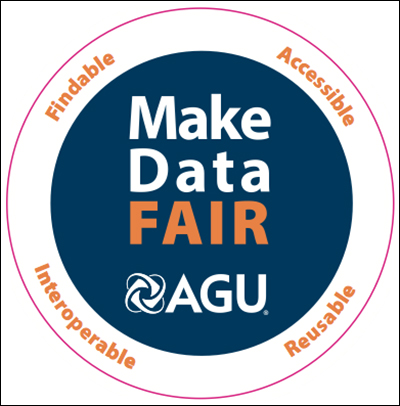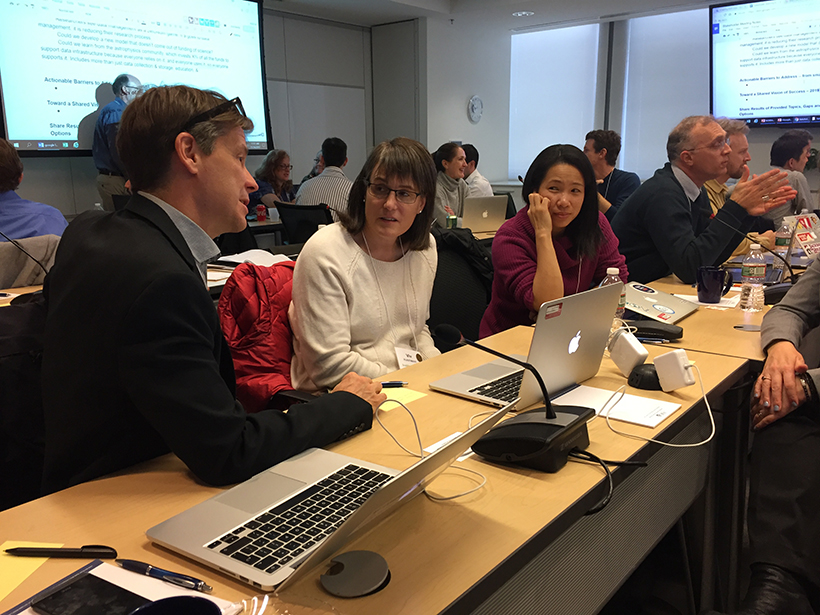Open, accessible, high-quality data, as well as related data products and software, are critical to ensure the integrity of published research and to facilitate reuse of the data in future work. This is particularly true in the Earth and space sciences, where integrated data sets increasingly provide diverse and important societal benefits and are used in critical real-time decisions. Unfortunately, data preservation and curation are uneven. And even when data are well preserved, they can lack adequate documentation or easy discoverability. The international Future of Research Communication and e-Scholarship organization, FORCE11, which was founded in 2011, has thus proposed that for data to be reusable the infrastructure should follow the Findable, Accessible, Interoperable, and Reusable (FAIR) guiding principles.

Thanks to a grant from the Laura and John Arnold Foundation, the American Geophysical Union (AGU) and other partners have just started a project to Enable FAIR Data across the Earth and space sciences. The goal of the project is to align publishers and repositories in following best practices to enable FAIR data and to create workflows so that researchers will have a simplified, common experience when submitting their paper to any leading Earth and space science journal. Project information can be found on the Coalition on Publishing Data in the Earth and Space Sciences’ website, and more information is in a recent Editor’s Vox about the project.
Project Objectives
- FAIR-compliant data repositories will add value to research data, provide metadata and landing pages for discoverability, and support researchers with documentation guidance, citation support, and peer review.
- FAIR-compliant Earth and space science publishers will align their policies to establish a similar experience for researchers. Data will be available through citations that resolve to repository landing pages. Data are not placed in the supplement.
Publishers, data repositories, and supporting organizations will work together to provide easy directories of repositories, standards for reporting data, and future governance.
This project just kicked off with a stakeholder meeting in Arlington, Va., on 16–17 November. This meeting summary aims to keep the community aware of progress and to allow others to join this effort and participate in further work.
Stakeholder Survey
Ahead of the workshop, we conducted a survey of key stakeholders (publishers, repositories, and supporting organizations) to set a baseline for how the FAIR data guiding principles are perceived and implemented currently. A total of 256 stakeholders responded by the time of the workshop (more responses are coming in). A total of 41% of the respondents reported their primary roles as data professionals, 35% as researchers, 8% as publishers, 2% as funders, and 14% in other roles. There was broad diversity across geoscience disciplines, years of experience, gender, and other metrics. Nearly 40% of the respondents were from outside the United States.
The greatest difficulty was thought to be around interoperability, with reusability a close second.
Respondents were asked how important each part of the FAIR principles is and how easy or difficult it is to achieve them. Three interesting findings emerged:
- The greatest difficulty was thought to be around interoperability, with reusability a close second. The first two parts of FAIR (finding and accessing data), although still challenging, were not seen as difficult.
- The concept of attaching a Digital Object Identifier (DOI) to data is becoming well established and accepted, meaning that DataCite and CrossRef have achieved success implementing this concept within the science researcher, publisher, and repository communities.
- The largest gap between importance and ease was around data repositories having reliable funding. The respondents felt that it is very important that repositories have reliable funding, but this need is seen as very difficult.
The survey is still open, and interested readers are welcome to contribute their opinions. Current survey results are available online.
The Meeting and Follow-up Work
One of the most exciting realizations of the workshop was that the necessary elements needed to effectively share data between repositories and publishers already exist at small scales.
More than 80 attendees participated in the kickoff meeting, which was aimed at aligning stakeholders and outlining and beginning initial work on developing solutions.
One of the most exciting realizations of the workshop was that the necessary elements needed to effectively share data between repositories and publishers already exist at small scales and that several other international community organizations are already engaged in work to implement parts of the FAIR principles. Thus, adoption across the Earth and space sciences requires, in part, aligning existing activities and ensuring widespread adoption of current standards and recommended practice.
The workshop formed several targeted adoption groups (TAGs) to guide this adoption while aligning with existing groups. Separate TAGs are addressing the following:
- Repository Guidance for Researchers
- Earth and Space Science (ESS) Publishers Aligning Standards (TAG name: Publishers in the ESS team)
- FAIR Resources and Training for Researchers
- Data and DOI Workflows and Handoffs
- Credit for Digital Products (TAG name: Culture Change through Credit)
- Key Elements of Active DMPs (liaison team to existing efforts; a DMP is a data management plan)
These groups are open to any interested participants, and details for joining may be found online. The goal is to complete the work by spring 2018, test the implementation in early summer, and begin community-wide implementation in midsummer.
For additional information and details on getting involved, contact Shelley Stall ([email protected]), AGU’s director of data programs. We are planning reports and in-person meetings at the AGU Fall Meeting, Earth Science Information Partners Meeting (8 January 2018), Research Data Alliance Plenary 11 (18 March 2018), and European Geosciences Union Meeting (10 April 2018).
—Shelley Stall (email: [email protected]), Director, Data Programs, AGU; Erin Robinson, Earth Science Information Partners, Boulder, Colo.; Lesley Wyborn, National Computational Research Infrastructure, Canberra, Australia; Lynn Rees Yarmey, Rensselaer Polytechnic Institute, Troy, N.Y.; also at Research Data Alliance/United States, Troy, N.Y.; Mark A. Parsons, Rensselaer Polytechnic Institute, Troy, N.Y.; also at Research Data Alliance, Troy, N.Y.; Kerstin Lehnert, Lamont-Doherty Earth Observatory, Columbia University, Palisades, N.Y.; Joel Cutcher-Gershenfeld, Heller School for Social Policy and Management, Brandeis University, Waltham, Mass.; Brian Nosek, Center for Open Science, University of Virginia, Charlottesville; and Brooks Hanson, Vice President, Publications, AGU
Citation:
Stall, S.,Robinson, E.,Wyborn, L.,Yarmey, L. R.,Parsons, M. A.,Lehnert, K.,Cutcher-Gershenfeld, J.,Nosek, B., and Hanson, B. (2017), Enabling FAIR data across the Earth and space sciences, Eos, 98, https://doi.org/10.1029/2017EO088425. Published on 08 December 2017.
Text © 2017. The authors. CC BY-NC-ND 3.0
Except where otherwise noted, images are subject to copyright. Any reuse without express permission from the copyright owner is prohibited.

